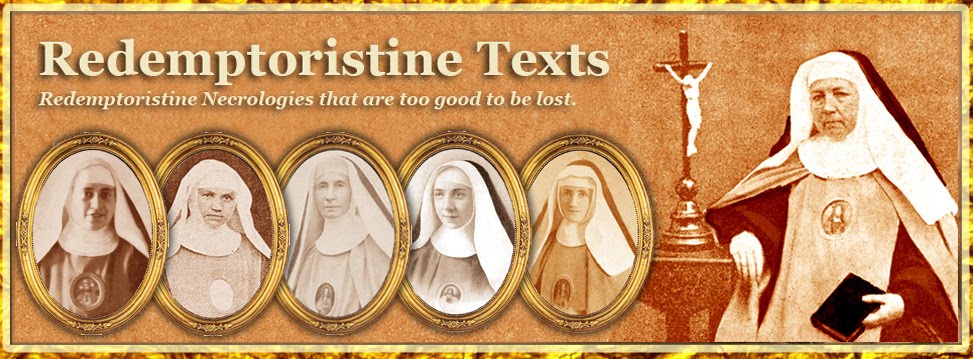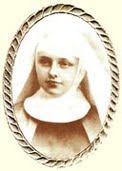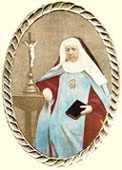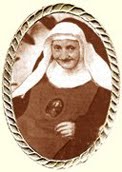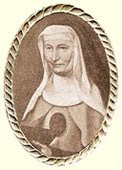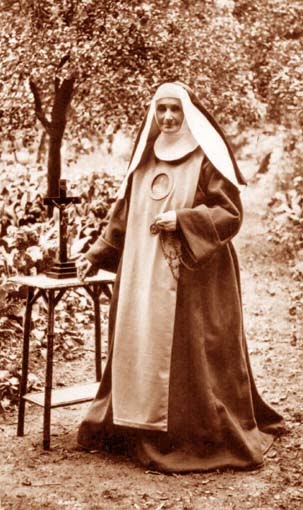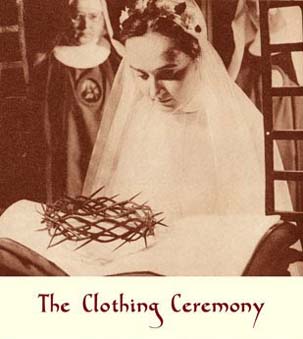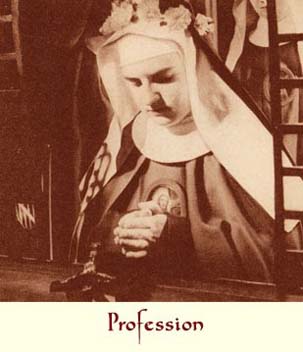Chapter V. Exile and the death of Mother Marie-Joseph.
I. Exile. – The Monastery of Kain-la-Tombe.
The year 1900 brought the Monastery of Saint-Amand a triple subject of joy. They were to celebrate at one and the same time the twenty-fifth anniversary of the establishment of the Redemptoristines in France; the superiority of Mother Marie-Joseph, who had lasted the same amount of time, and finally, the twenty five years in which Father Vaillant had exercised his functions of Chaplain to the Monastery with an admirable zeal.
Everything was done with devotion and the accustomed warmth. The great solemn Mass was accompanied by the singing of the College, and a special sermon for the occasion, a far from ordinary one, was preached by Rev. Fr. Arséne, Redemptorist. Their gratitude and love was transmitted in a thousand ways as varied as they were touching. We should not forget to mention here the two Sisters [4] who had most particularly shared with their Mother the work and suffering of the foundation. And the deceased Sisters, the parents and benefactors who had passed away, all had their fair share of suffrages and prayers.
But so joyful a feast was to be succeeded by more sombre days. At the end of the 18th Century (1790), the Benedictines of Saint-Amand had seen their magnificent abbey become the prey of the revolutionaries, and now the Redemptoristines of Saint-Amand were to see their beautiful Monastery fall into the hands of a greedy treasury, and the road to exile open up before them. Summoned to ask the government for an authorisation which would have been only an illusory one, and in every case very precarious, Mother Marie-Joseph preferred to ask Belgium for its generous hospitality where she and her daughters could at least serve God tranquilly and pray to Him in peace for their ungrateful country. And then she could remember how her Sisters from Vienna, in 1848, had themselves had to bow to the storm and ask neighbouring countries for the liberty snatched away from them by the Revolution. How could she ever forget how Mother Marie-Alphonse, whose Life [5] she had just read, had herself sought refuge in Belgium and had even received amongst the number of her daughters the future Superior of Saint-Amand?
The test was no less a cruel one. It meant saying farewell to the Monastery where they had all spent the best part of their lives and spent the best part of their energies, where pains and joys had been mingled to make the link closer which united their hearts to the blessed walls where they had become a close community. This cloister and this chapel where they had prayed so much together, they now had to leave! The good Mother’s heart was distraught with grief, but her faith and her energy soon took the upper hand. With an unparalleled courage, she went to Tournai and searched for a refuge in the suburbs where she could take her community, no less strong and no less resigned than herself. She spared herself neither journeys nor effort, and finally found a temporary swelling at Kain-la-Tombe. It was a country house, the property of the Count of Hespel. She rented it, adapted it to the present necessities, and installed herself there. She decided to leave Saint-Amand on 25th August 1901, and on 19th September, the feast of Our Lady of Salette, the departure of the exiles took place. Mons. Monnier, their devoted protector, gave them his blessing. A short time afterwards, Mons. Walravens, the Bishop of Tournai, came to give his own to the reunited community. Some months later, the venerable Prelate came to bless her and encourage her once more.
There were not too many of these consolations. Their afflicted hearts had such need, that their Fathers in the faith offered them their sympathies and assured them of their protection! But the Mother had in no way failed her children. Indefatigable in putting everything in order in their new home, she made sure with the solicitude of a Mother that spiritual help was in no way lacking for her children. The episcopal College of Kain came to her aid in this respect with an admirable devotion. On the other hand, the revered Mother gladly reminded her children of the examples of Our Lady of the Seven Sorrows, and got them to offer their sacrifices to God for this redemption of souls which was the purpose of their whole lives. These were noble thoughts which elevated their hearts above the sorrows of this world and made them courageously accept the harshest trials!
However, these rude shocks had undermined the health of Reverend Mother Marie-Joseph. Several nasal haemorrhages, judged very grave by the doctor, had surprised her in the midst of her labours and alarmed the community. Prayers led to an improvement. On 29th December they were able to celebrate the ninth re-election of the much-beloved Superior, and hearts began to fill with hope again. But a burning pain remained in the good Mother’s heart, that of not being able to establish the enclosure in this house which she had rented for only three years. Her energy and her love of religious regularity made her take on new labours, but this time it was her life that was under threat, as she did not spare herself.
A spacious property, formerly the therapeutic establishment of Kneipp, situated not far from her former house, became available. The courageous Mother obtained permission from the Bishop to acquire it. The contract was signed on 20th March 1903, and they immediately began the work of adapting the house for its new purpose. However, they had to build a chapel and parlours. The construction work soon began. This time, so many preoccupations added to the heart complaint from which the revered Mother suffered, that they took a toll on her constitution, and she had to renounce the supervision of the work. One of her most devoted daughters said: “From then on her life became on long series of sufferings that crucified her and enriched her with merits for heaven by making her practise the most heroic virtues. For more than six months she had to take her rest in an armchair, yet it was still a long time before she would allow one of her children to sleep next to her in her room. Besides, her long insomnias permitted her to deliver herself at leisure to her prayers, and this exercise was her strength and consolation. Soon she let some words escape that seemed to announce to her dear daughters a coming separation. Then she put her papers in order, tore up and burnt all those which were of a personal nature, went to confession regularly twice a week, and held herself ready to respond to the call of her divine Spouse. Some months before her death, in memory of the terrible haemorrhage of 1st November 1902, she pronounced these words: “Oh, the anniversary! What will it bring us this year? By the grace of God, may His holy will be done!” and she accompanied these words with a significant gesture. Soon, in fact, her soul was to take its flight to its homeland.
II. Death of Mother Marie-Joseph of the Child Jesus.
“The more the end of our Mother’s life approached,” continues the narrator, “the more also her goodness was manifested, at the same time as her sanctity. Every day, morning and evening, she would bless her children and always a few words of piety and edification to them. She did her best to attend the common recreations, knowing how much her presence was agreeable to us. She herself appeared happy in the midst of her daughters, who showed her their respectful affection. When the time permitted her, she would go out in a little carriage along the paths in the park, surrounded by her dear community, and we all competed zealously with each other to render her this service. But always, before going back to her room to take a little rest, she would pay a visit to the Blessed Sacrament."
Every day, she would attend the Holy Mass and take communion. She would often tell us about the benefits of suffering. She would say: “Meditate on the blessings of the Cross. Suffering is a great grace, so accept with love and gratitude everything that Jesus sends us. If we wish to be true Redemptoristines, we should know how to suffer.” She also said: “Let us love the good God well, my children, let us ask Him to make Himself known and loved. There are so many people who no longer want Him! We at least should love Him with all our hearts, so that, on this little corner of the earth, He may be well loved and served.” “O Mary,” she sometimes cried out, “take from the Heart of your Jesus a little spark of love that it encloses, make in burn in our souls.”
Thus the good Mother Marie-Joseph went gently towards her eternity. Faithful to her exercises of piety until her very last day, she satisfied the obligation to the Divine Office as far as her sufferings permitted her, but soon they increased. Apoplexy, the beginning of congestion and a painful eczema all struck her in succession. She offered nothing but the most entire resignation and her usual prayer: “My God, give me patience.” In spite of her pains, she never lost sight of the removal of the community into its new home, and finally fixed the departure for 21st November. But, like Moses, she was not destined to enter this Promised Land. The Blessed Virgin had reserved another for her.
On 11th November, while the Sisters were reciting the Vespers of the day in choir and saying with the disciples of the great Saint Martin: “Father, why have You abandoned us? To whom have You left your grieving sons?”, Mother Marie-Joseph was struck with paralysis. Soon her speech was affected, and the revered invalid was deprived of the ability to speak. A priest, a friend of the community, was there in the convent. He judged it prudent to administer the last sacraments to Mother. She received them with a tender piety, as she still had the lucidity of her mind, and followed all the prayers and ceremonies with great faith. The haste with which it was necessary to proceed to the administration did not permit her disconsolate daughters any demonstration, and this simplicity even helped them in their sorrow.
“The recreations were suppressed,” says the narrator, “and everyone started praying. The following day, the Rosary was recited the whole day, and the chapel did not cease to be the witness of our supplications. But the Lord remained deaf to our ardent desires. Her illness gradually got worse, her paralysis increased, and all hope soon vanished. We were scarcely able to guess if our good Mother was still conscious, but sometimes, however, her eyes recovered their power, and one could have said that she wanted us to understand her thoughts. We made use of this to address some good words to her, but everything stopped there. How much sacrifice and suffering did this state impose on our revered Mother! As for us, we were doubly afflicted by not being able to speak to her or understand her. She was about to leave us without being able to give her last recommendations and receive the homage of our filial love.
"On the 17th, at four o’clock in the morning, the Infirmarians believed that our Reverend Mother was entering into her agony and warned the community, but this state continued right into the following night. They recited the prayers of the agonising, and during the day, the Father Superior and the Parish Priest of La Tombe gave the holy Mother the indulgences in articulo mortis [at the moment of death]. It was at about one-thirty, on the night of Wednesday 18th, that our revered Mother and foundress rendered her beautiful soul to God, surrounded by all her children. She was in her 68th year of age, her 47th year of her religious life, and her 28th year of Superiority. Her death had been as gentle and calm as her life, and it was under the auspices of Saint Joseph her special patron and the Patron of a good death, that her soul took its flight.
“The funeral service was celebrated on 21st November, on the feast of the Presentation of the Blessed Virgin. The Sisters did not even have the consolation of keeping the mortal remains of their good Mother, near them, in a cemetery that belonged to the community, as authorisation for it had not been granted to them. They decided to have her transported to the community vault at Nivelles, near Saint-Amand. There Mother Marie-Joseph of the Child Jesus seems to still watch over the Monastery that was formerly erected by her cares, and await her religious exiles at the moment marked out by the will of God.”
Epilogue.
Many tributes were paid to the memory of the revered Mother, but none, in our opinion, surpasses the one that Father Vaillant, the former Chaplain of the Redemptoristines of Saint-Amand-les-Eaux, dedicated to her in the following pages:
“What Mother Marie-Joseph never lost sight of, and what she excelled in, was making her community a truly Alphonsian community, that is to say, completely impregnated and devoted to the spirit of the holy Founder, his principles, his maxims, his teachings, his doctrines, his virtues, and his preferred devotions – in a word, devoted to forming her spiritual daughters in the school and upon the model of the holy Doctor.
“We should recall here that Saint Alphonsus was not simply one of the greatest saints who have shone in the Church. He was also an eminent director of souls, an incomparable doctor and master in the ways of perfection. All the Popes who have succeeded since his death have been pleased to praise his doctrine and his maxims, and recommend them as eminently proper to the sanctification of souls, and to elevating them to the highest peaks of virtue. Both the instructions too of the Reverend Mother, her opinions, her habitual recommendations, as well as the particular direction of each one of the religious, were profoundly marked by this Alphonsian imprint. She herself preached by example, showing herself in everything the image of her Blessed Father. To this special formation she consecrated all her prayers, her efforts, an indefatigable zeal, and her whole soul. Her great and only ambition was to light the fire of true love in the souls of her daughters, and to make it reign there as the master. She had the ineffable consolation of succeeding in it. A quality developed to a rare degree in the heart of the Reverend Mother contributed powerfully to this result. I mean by this the very maternal affection with which she surrounded each one of her daughters, an affection which was truly devout, strong, supernatural, and entirely inspired by a zeal for their perfection. In return, her daughters offered her the most tender affection and the most sincere obedience.
“The Monastery of Saint-Amand was consecrated to the Holy Family and bore their name. Consequently, this was the model always proposed for the imitation of the religious who lived there, and invitation which was always encouraging them to bring about everything this beautiful name recalls, and reproduce the life and virtues of the Holy Family of Nazareth. Mother Marie-Joseph of the Child Jesus could never forget this for a single instant. She put her whole heart and her whole soul into bringing into her community the ineffable union that reigned between Jesus, Mary and Joseph. What happiness for this very loving Mother to manage to establish among her daughters a perfect union of spirits and hearts, an inalterable peace, friendship and cordiality in all their relationships! This view enraptured her heart and brought her a wonderful happiness, paying her for all her labours.
“In addition, the Reverend Mother did not like melancholy, or a bad and taciturn humour. She wanted to see her daughters habitually bright, happy and outgoing, with their faces calm and relaxed, with a disposition always even and open, edifying each other mutually. She herself preached by example, in spite of the continual cares of her position. It was one of her favourite maxims that sadness and concentration on oneself depresses the strength of the soul and the energies of the will, while spiritual joy doubles them, supports generosity and the spirit of sacrifice, and makes us accept everything with warmth, joy and as she said herself, joyfully.”
The year 1900 brought the Monastery of Saint-Amand a triple subject of joy. They were to celebrate at one and the same time the twenty-fifth anniversary of the establishment of the Redemptoristines in France; the superiority of Mother Marie-Joseph, who had lasted the same amount of time, and finally, the twenty five years in which Father Vaillant had exercised his functions of Chaplain to the Monastery with an admirable zeal.
Everything was done with devotion and the accustomed warmth. The great solemn Mass was accompanied by the singing of the College, and a special sermon for the occasion, a far from ordinary one, was preached by Rev. Fr. Arséne, Redemptorist. Their gratitude and love was transmitted in a thousand ways as varied as they were touching. We should not forget to mention here the two Sisters [4] who had most particularly shared with their Mother the work and suffering of the foundation. And the deceased Sisters, the parents and benefactors who had passed away, all had their fair share of suffrages and prayers.
But so joyful a feast was to be succeeded by more sombre days. At the end of the 18th Century (1790), the Benedictines of Saint-Amand had seen their magnificent abbey become the prey of the revolutionaries, and now the Redemptoristines of Saint-Amand were to see their beautiful Monastery fall into the hands of a greedy treasury, and the road to exile open up before them. Summoned to ask the government for an authorisation which would have been only an illusory one, and in every case very precarious, Mother Marie-Joseph preferred to ask Belgium for its generous hospitality where she and her daughters could at least serve God tranquilly and pray to Him in peace for their ungrateful country. And then she could remember how her Sisters from Vienna, in 1848, had themselves had to bow to the storm and ask neighbouring countries for the liberty snatched away from them by the Revolution. How could she ever forget how Mother Marie-Alphonse, whose Life [5] she had just read, had herself sought refuge in Belgium and had even received amongst the number of her daughters the future Superior of Saint-Amand?
The test was no less a cruel one. It meant saying farewell to the Monastery where they had all spent the best part of their lives and spent the best part of their energies, where pains and joys had been mingled to make the link closer which united their hearts to the blessed walls where they had become a close community. This cloister and this chapel where they had prayed so much together, they now had to leave! The good Mother’s heart was distraught with grief, but her faith and her energy soon took the upper hand. With an unparalleled courage, she went to Tournai and searched for a refuge in the suburbs where she could take her community, no less strong and no less resigned than herself. She spared herself neither journeys nor effort, and finally found a temporary swelling at Kain-la-Tombe. It was a country house, the property of the Count of Hespel. She rented it, adapted it to the present necessities, and installed herself there. She decided to leave Saint-Amand on 25th August 1901, and on 19th September, the feast of Our Lady of Salette, the departure of the exiles took place. Mons. Monnier, their devoted protector, gave them his blessing. A short time afterwards, Mons. Walravens, the Bishop of Tournai, came to give his own to the reunited community. Some months later, the venerable Prelate came to bless her and encourage her once more.
There were not too many of these consolations. Their afflicted hearts had such need, that their Fathers in the faith offered them their sympathies and assured them of their protection! But the Mother had in no way failed her children. Indefatigable in putting everything in order in their new home, she made sure with the solicitude of a Mother that spiritual help was in no way lacking for her children. The episcopal College of Kain came to her aid in this respect with an admirable devotion. On the other hand, the revered Mother gladly reminded her children of the examples of Our Lady of the Seven Sorrows, and got them to offer their sacrifices to God for this redemption of souls which was the purpose of their whole lives. These were noble thoughts which elevated their hearts above the sorrows of this world and made them courageously accept the harshest trials!
However, these rude shocks had undermined the health of Reverend Mother Marie-Joseph. Several nasal haemorrhages, judged very grave by the doctor, had surprised her in the midst of her labours and alarmed the community. Prayers led to an improvement. On 29th December they were able to celebrate the ninth re-election of the much-beloved Superior, and hearts began to fill with hope again. But a burning pain remained in the good Mother’s heart, that of not being able to establish the enclosure in this house which she had rented for only three years. Her energy and her love of religious regularity made her take on new labours, but this time it was her life that was under threat, as she did not spare herself.
A spacious property, formerly the therapeutic establishment of Kneipp, situated not far from her former house, became available. The courageous Mother obtained permission from the Bishop to acquire it. The contract was signed on 20th March 1903, and they immediately began the work of adapting the house for its new purpose. However, they had to build a chapel and parlours. The construction work soon began. This time, so many preoccupations added to the heart complaint from which the revered Mother suffered, that they took a toll on her constitution, and she had to renounce the supervision of the work. One of her most devoted daughters said: “From then on her life became on long series of sufferings that crucified her and enriched her with merits for heaven by making her practise the most heroic virtues. For more than six months she had to take her rest in an armchair, yet it was still a long time before she would allow one of her children to sleep next to her in her room. Besides, her long insomnias permitted her to deliver herself at leisure to her prayers, and this exercise was her strength and consolation. Soon she let some words escape that seemed to announce to her dear daughters a coming separation. Then she put her papers in order, tore up and burnt all those which were of a personal nature, went to confession regularly twice a week, and held herself ready to respond to the call of her divine Spouse. Some months before her death, in memory of the terrible haemorrhage of 1st November 1902, she pronounced these words: “Oh, the anniversary! What will it bring us this year? By the grace of God, may His holy will be done!” and she accompanied these words with a significant gesture. Soon, in fact, her soul was to take its flight to its homeland.
II. Death of Mother Marie-Joseph of the Child Jesus.
“The more the end of our Mother’s life approached,” continues the narrator, “the more also her goodness was manifested, at the same time as her sanctity. Every day, morning and evening, she would bless her children and always a few words of piety and edification to them. She did her best to attend the common recreations, knowing how much her presence was agreeable to us. She herself appeared happy in the midst of her daughters, who showed her their respectful affection. When the time permitted her, she would go out in a little carriage along the paths in the park, surrounded by her dear community, and we all competed zealously with each other to render her this service. But always, before going back to her room to take a little rest, she would pay a visit to the Blessed Sacrament."
Every day, she would attend the Holy Mass and take communion. She would often tell us about the benefits of suffering. She would say: “Meditate on the blessings of the Cross. Suffering is a great grace, so accept with love and gratitude everything that Jesus sends us. If we wish to be true Redemptoristines, we should know how to suffer.” She also said: “Let us love the good God well, my children, let us ask Him to make Himself known and loved. There are so many people who no longer want Him! We at least should love Him with all our hearts, so that, on this little corner of the earth, He may be well loved and served.” “O Mary,” she sometimes cried out, “take from the Heart of your Jesus a little spark of love that it encloses, make in burn in our souls.”
Thus the good Mother Marie-Joseph went gently towards her eternity. Faithful to her exercises of piety until her very last day, she satisfied the obligation to the Divine Office as far as her sufferings permitted her, but soon they increased. Apoplexy, the beginning of congestion and a painful eczema all struck her in succession. She offered nothing but the most entire resignation and her usual prayer: “My God, give me patience.” In spite of her pains, she never lost sight of the removal of the community into its new home, and finally fixed the departure for 21st November. But, like Moses, she was not destined to enter this Promised Land. The Blessed Virgin had reserved another for her.
On 11th November, while the Sisters were reciting the Vespers of the day in choir and saying with the disciples of the great Saint Martin: “Father, why have You abandoned us? To whom have You left your grieving sons?”, Mother Marie-Joseph was struck with paralysis. Soon her speech was affected, and the revered invalid was deprived of the ability to speak. A priest, a friend of the community, was there in the convent. He judged it prudent to administer the last sacraments to Mother. She received them with a tender piety, as she still had the lucidity of her mind, and followed all the prayers and ceremonies with great faith. The haste with which it was necessary to proceed to the administration did not permit her disconsolate daughters any demonstration, and this simplicity even helped them in their sorrow.
“The recreations were suppressed,” says the narrator, “and everyone started praying. The following day, the Rosary was recited the whole day, and the chapel did not cease to be the witness of our supplications. But the Lord remained deaf to our ardent desires. Her illness gradually got worse, her paralysis increased, and all hope soon vanished. We were scarcely able to guess if our good Mother was still conscious, but sometimes, however, her eyes recovered their power, and one could have said that she wanted us to understand her thoughts. We made use of this to address some good words to her, but everything stopped there. How much sacrifice and suffering did this state impose on our revered Mother! As for us, we were doubly afflicted by not being able to speak to her or understand her. She was about to leave us without being able to give her last recommendations and receive the homage of our filial love.
"On the 17th, at four o’clock in the morning, the Infirmarians believed that our Reverend Mother was entering into her agony and warned the community, but this state continued right into the following night. They recited the prayers of the agonising, and during the day, the Father Superior and the Parish Priest of La Tombe gave the holy Mother the indulgences in articulo mortis [at the moment of death]. It was at about one-thirty, on the night of Wednesday 18th, that our revered Mother and foundress rendered her beautiful soul to God, surrounded by all her children. She was in her 68th year of age, her 47th year of her religious life, and her 28th year of Superiority. Her death had been as gentle and calm as her life, and it was under the auspices of Saint Joseph her special patron and the Patron of a good death, that her soul took its flight.
“The funeral service was celebrated on 21st November, on the feast of the Presentation of the Blessed Virgin. The Sisters did not even have the consolation of keeping the mortal remains of their good Mother, near them, in a cemetery that belonged to the community, as authorisation for it had not been granted to them. They decided to have her transported to the community vault at Nivelles, near Saint-Amand. There Mother Marie-Joseph of the Child Jesus seems to still watch over the Monastery that was formerly erected by her cares, and await her religious exiles at the moment marked out by the will of God.”
Epilogue.
Many tributes were paid to the memory of the revered Mother, but none, in our opinion, surpasses the one that Father Vaillant, the former Chaplain of the Redemptoristines of Saint-Amand-les-Eaux, dedicated to her in the following pages:
“What Mother Marie-Joseph never lost sight of, and what she excelled in, was making her community a truly Alphonsian community, that is to say, completely impregnated and devoted to the spirit of the holy Founder, his principles, his maxims, his teachings, his doctrines, his virtues, and his preferred devotions – in a word, devoted to forming her spiritual daughters in the school and upon the model of the holy Doctor.
“We should recall here that Saint Alphonsus was not simply one of the greatest saints who have shone in the Church. He was also an eminent director of souls, an incomparable doctor and master in the ways of perfection. All the Popes who have succeeded since his death have been pleased to praise his doctrine and his maxims, and recommend them as eminently proper to the sanctification of souls, and to elevating them to the highest peaks of virtue. Both the instructions too of the Reverend Mother, her opinions, her habitual recommendations, as well as the particular direction of each one of the religious, were profoundly marked by this Alphonsian imprint. She herself preached by example, showing herself in everything the image of her Blessed Father. To this special formation she consecrated all her prayers, her efforts, an indefatigable zeal, and her whole soul. Her great and only ambition was to light the fire of true love in the souls of her daughters, and to make it reign there as the master. She had the ineffable consolation of succeeding in it. A quality developed to a rare degree in the heart of the Reverend Mother contributed powerfully to this result. I mean by this the very maternal affection with which she surrounded each one of her daughters, an affection which was truly devout, strong, supernatural, and entirely inspired by a zeal for their perfection. In return, her daughters offered her the most tender affection and the most sincere obedience.
“The Monastery of Saint-Amand was consecrated to the Holy Family and bore their name. Consequently, this was the model always proposed for the imitation of the religious who lived there, and invitation which was always encouraging them to bring about everything this beautiful name recalls, and reproduce the life and virtues of the Holy Family of Nazareth. Mother Marie-Joseph of the Child Jesus could never forget this for a single instant. She put her whole heart and her whole soul into bringing into her community the ineffable union that reigned between Jesus, Mary and Joseph. What happiness for this very loving Mother to manage to establish among her daughters a perfect union of spirits and hearts, an inalterable peace, friendship and cordiality in all their relationships! This view enraptured her heart and brought her a wonderful happiness, paying her for all her labours.
“In addition, the Reverend Mother did not like melancholy, or a bad and taciturn humour. She wanted to see her daughters habitually bright, happy and outgoing, with their faces calm and relaxed, with a disposition always even and open, edifying each other mutually. She herself preached by example, in spite of the continual cares of her position. It was one of her favourite maxims that sadness and concentration on oneself depresses the strength of the soul and the energies of the will, while spiritual joy doubles them, supports generosity and the spirit of sacrifice, and makes us accept everything with warmth, joy and as she said herself, joyfully.”
Footnotes
[4] Reverend Sister Marie-Claire of the Blessed Sacrament, and Reverend Sister Marie-Angèle of the Precious Blood.
[5] See the Life of Mother Marie-Alphonse of the Will of God, by Father Nimal, Redemptorist.
[5] See the Life of Mother Marie-Alphonse of the Will of God, by Father Nimal, Redemptorist.
This necrology is translated from Fleurs de l'Institut des Rédemptoristines by Mr John R. Bradbury. The copyright of this translation is the property of the Redemptoristine Nuns of Maitland, Australia. The integral version of the translated book will be posted here as the necrologies appear.
